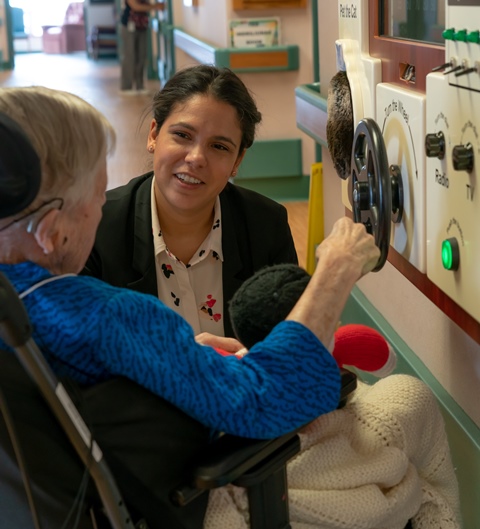By Annie Atkinson
Patricia Laurin says her 92-year-old mother Shirrill Crawford has been “totally lost” for several years due to Alzheimer’s disease. “She doesn’t know me. Her memory is really compromised.”
Yet the day ABBY—a wall-mounted personalized activity technology—was installed at Crawford’s Midland, Ontario long-term care home, she became “totally engaged for 90 minutes. It blew me away when she named my grandmother and my brother in pictures” displayed on the screen, says Laurin.
“My mother manipulated the board and got a meaningful response from it. It stirred a lot of memories and she was fascinated by the music and pictures. It was amazing to see her so engaged, relaxed and enjoying herself.”
The ABBY system integrates touch-screen monitors, video, music and familiar tactile activities such as turning a wheel or petting a cat to create engaging experiences for long-term care residents with dementia. What’s more, if the resident is wearing a Bluetooth beacon, it signals to the unit to pull up personalized content including family photographs, a resident’s favourite music or TV show.
ABBY, which uses a Montessori approach, was developed by industry partner Ambient Activity Technologies in collaboration with a Toronto-based research team and with support from AGE-WELL, Canada’s Technology and Aging Network.
“We knew there was a problem with keeping people engaged in meaningful activities, so we wanted to physically activate people. You have to approach the ABBY unit, physically engage with it, and then in response you get this content that is meaningful,” says project co-lead Dr. Andrea Wilkinson, a postdoctoral research fellow at the University of Toronto, AGE-WELL trainee and founder of Brain Shape Inc.
Results are impressive. A 2017 study using ABBY at six long-term care homes showed a decrease in agitation, aggression, anxieties and paranoid delusions among residents living with dementia, along with improved quality of life. Staff experienced reduced burnout and for family members, outcomes included visitor satisfaction.
“There is still so much left in people with dementia. If we can help them access these long-term memories that still exist so they can have meaningful conversations with their loved ones, this can bring such joy to the individual and to the family members,” says Dr. Wilkinson.
Using content from their own lives draws the attention of residents to ABBY. “There is a genuine problem with triggering activity among people living with dementia. Familiar actions like petting a cat or turning a wheel use implicit knowledge that remains after a lifetime of use. Once the activity board reacts to their input, people become engaged and no further triggering is required,” explains Dr. Mark Chignell, who is project co-lead, a psychologist and a professor in the Department of Mechanical and Industrial Engineering at the University of Toronto.
“People are spending hours with ABBY. What I like about this project is the potential impact it could have for the almost 50 million people worldwide who live with dementia.”
In Canada, approximately 62 per cent of residents in long-term care homes have dementia and nearly half exhibit aggressive or agitated behaviour.
Boredom and lack of meaningful, engaging activities may be associated with increases in responsive behaviours, such as screaming and wandering. ABBY could prove to be an important part of a strategy to engage people living with dementia in long-term care.
Marc Kanik, managing director of Ambient Activity Technologies, is travelling the country to introduce ABBY to long-term care homes. Orders are coming in. About two dozen units already have been installed in Ontario homes.
“Everybody in our company feels good about working on something that has this kind of impact in bettering people’s lives,” says Kanik.
Annie Atkinson is a freelance writer. AGE-WELL is a federally-funded Network of Centres of Excellence. The pan-Canadian network brings together researchers, older adults, caregivers, partner organizations and future leaders to accelerate the delivery of technology-based solutions for healthy aging. For more information, visit http://agewell-nce.ca/




